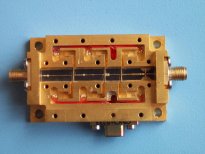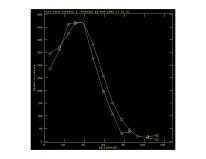
Newsletter

 |
Newsletter |  |
| Number 9: September 2003 | ||||
| MERLIN | VLBI AT JBO | PROPOSALS | ARCHIVE | CONTACT |
This newsletter may also be downloaded as a pdf file from here
| Contents | |
The deadline for the receipt of proposals for Semester 04A (February 2004 - June 2004) on MERLIN is September 15th, 2003. All details are in the MERLIN web area, specifically; http://www.merlin.ac.uk/propsub/call.
Observing frequencies available:
**Surface alignment of the Lovell telescope will be an iterative process with the first stage planned for Summer 2003. The new C-Band receivers and LOs are scheduled for installation during Semester 03B. Improvements and upgrades will be incremental and the fully enhanced sensitivity is unlikely to be realized before the latter part of2004.
The system parameters for observation of a continuum source in good weather conditions are;
| C-Band(New) | C-Band | K-Band | |
| Maximum angular resolution (mas) | ~40 | ~40 | ~8 |
| R.M.S. noise level for 12 hr. on source (microJy/beam) | ~20 | ~50 | ~400 |
| Maximum bandwidth per polarization (MHz) | ~15 | ~15 | ~15 |
The use of the fully aligned Lovell telescope at C-Band with the new receiver systems reduces the 12 hour RMS noise level to ~20 microJy/beam. The maximum rate at which the observing frequency can be switched within an observing band will be approximately once every five minutes for multi-frequency synthesis (MFS) observations. MFS is possible within each C-Band range (eg 4.5GHz-5.2GHz), but not possible between 4.5/5.2GHz and 6/7GHz. For spectral line work throughout the Semester, users are referred to Table 4.4 of the MERLIN User Guide Version 3 which is now available online. The maximum number of frequency channels per baseline to be divided between the 4 polarizations for bandwidths of 16 MHz, 8 MHz and 4 MHz are 64, 128 and 256, respectively. The number of frequency channels per baseline to be divided between the 4 polarizations will be 512 for bandwidths of 2 MHz or less. The minimum total bandwidth is 250 kHz.
Users who have obtained single-baseline (Mk2-Cambridge) data at 6-7GHz should inform the MERLIN TAG of the status of their project when applying for new observations with full MERLIN.
Proposal forms, information on MERLIN Key Programmes, and further general information can be obtained via;
It's that time again. Time flies, and none more so than in this last six months. However, there is a lot to report. As always, our major pre-occupation is with e-MERLIN. The project is going well; the major event was the recent successful selection of a contractor to deliver the fibre-optic cable that is the heart of the system. Negotiations on a contract are on-going and we expect to sign it in the next few weeks. We then hope that work on the system will start well early in 2004. As reported elsewhere in this newsletter, work on the development of the new 4-8 GHz system is moving forwards. We expect the first system to be mounted in November and others to be delivered soon after. The integration and testing of the new receivers will inevitably cause some disruption to our observing schedule and we ask for our user's understanding. The long-term benefits should far outweigh any short-term inconvenience.
A major success that occurred over the summer, and will be of interest to users of MERLIN, was the announcement by the European Commission that the Integrated Infrastructure Initiative proposal RadioNet was highly ranked (No.1 amongst all astronomy proposals) and that, following the successful conclusion of contract negotiations, will be awarded ~12.4MEuro. RadioNet is a proposal aimed at benefiting all of European radio astronomy; it has three major components:
We hope that money will be available from January 2004. More information will be provided in due course.
MERLIN will return from the summer engineering break at C/K-band (5 and 22 GHz) - see the call for proposals. It will remain at these frequencies until June/July 2004. This was announced in a previous newsletter and is necessary to avoid the time-consuming frequency change that we usually undertake. Our engineering staff have to focus on e-MERLIN as much as possible.
P. J. Diamond (pdiamond@jb.man.ac.uk)
This summer we selected the supplier for the optical fibre connections which will link the e-MERLIN telescopes to Jodrell bank with a bandwidth of 30 Gb/s from each telescope. This is a key part of the project and until now has been an area of significant uncertainty both in terms of cost and technical implementation. We are now happy that the proposed solution represents good value for money and is straightforward to implement. These links will involve some trunk fibre and new digs to the individual telescopes. The civil engineering work should start early in 2004 and should be complete by mid 2005. The contract for this work should be signed this autumn and more detailed information will be released then.
The C-band receiver development is also progressing well: new low noise amplifiers have been built and are now under test, the orthomode transducer has been manufactured and is also under test and the remaining feeds have also been manufactured and tested.

|
Interim down-converters to allow the new receivers to be used at 6-6.7 GHz (for observing excited OH and methanol lines) have been designed and tested and are now being manufactured.
Detailed design of the L-band lens mechanism is underway by an outside contractor and machining of the first 350-kg, 1.7-m diameter lens has now begun. Installation of the first L-band lens and deployment mechanism on the Pickmere telescope is scheduled for this autumn. The remaining 2 VLA-type antennas in MERLIN (Darnhall and Knockin) are scheduled to have their L-band lenses installed during the summer of 2004.
The L-band lenses, once installed, will allow MERLIN to be fully frequency flexible and permit rapid frequency changes between L-band, C-band, and K-band and is being undertaken as part of the e-MERLIN upgrade.
S. T. Garrington (stg@jb.man.ac.uk)
The nature of genuine Carbon stars with Oxygen-rich environments during the Asymptotic Giant Branch phase of copious mass-loss has been unclear since their discovery. Their spectra up to ~6.5microns are almost identical to that of true Carbon stars, whilst at longer wavelengths they are dominated by strong silicate emission typical for Oxygen-rich Miras. Detection of OH and H2O masers confirm the presence of Oxygen-rich Chemistry.
MERLIN phase-referencing observations of water maser emission from one of these objects (V778 Cyg), has revealed a molecular disc for the first time (Szymczak et al., in prep.). The H2O maser components form a distorted "S" shaped structure in position angle -20 degrees. In addition, there is a clear velocity gradient along this structure with the weaker southern components blue-shifted with respect to the brighter northern features. The distribution of maser spots is consistent with a disc model in which the disc major axis is displaced by 0.30 +/-0.07 arcsec from the optical position of V778 Cyg as measured by Tycho-2. This implies that the Oxygen-rich matter is stored in a disc around a companion star in a wide separation system.
M. Szymczak (msz@astro.uni.torun.pl)
A new deep MERLIN 5GHz image of M82 has been made following an 8-day integration. This is the most sensitive high resolution image that has yet been made of the central region of this nearby (d=3.2Mpc) starburst galaxy. The data were taken during 2002 and the r.m.s. noise level achieved in the final image is around 17microJy/beam. Detailed comparisons of the radio structures for the four most compact supernova remnants in M82 have been made by comparing this deep 2002 image with an astrometrically aligned image from a 36 hour integration made in 1992.

|
For the two most compact remnants, 41.95+575 and 43.31+592, expansion velocities of 2800 +/-300 km/s and 8750 +/- 400 km/s have been derived. These confirm and refine the measured expansion velocities which have been derived from multi-epoch VLBI studies. For remnants 43.18+583 and 44.01+596 respectively, expansion velocities of 10500 +/- 750 km/s and 2400 +/- 250 km/s have been measured for the first time. In addition, the peak of the radio emission for SNR 45.17+612 (which shows only a partial shell structure) has moved between the two epochs implying velocities around 7500 km/s. The relatively compact remnants in M82 are thus found to be expanding over a wide range of velocities which appear unrelated to their size. The new 2002 map establishes a first epoch for subsequent long-term deep studies which should reveal the expansion velocities for many SNR within M82. These latest results will appear in the proceedings of IAU Colloquium 192, (2003).
T. W. B. Muxlow (twbm@jb.man.ac.uk)